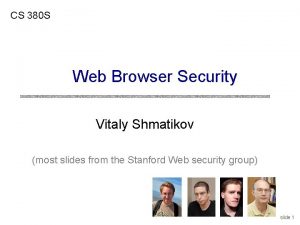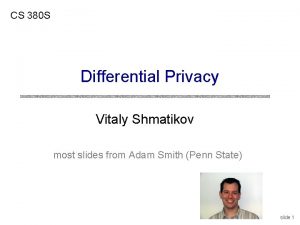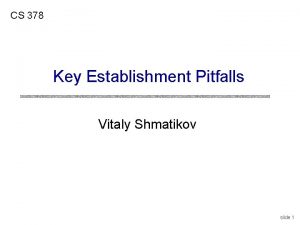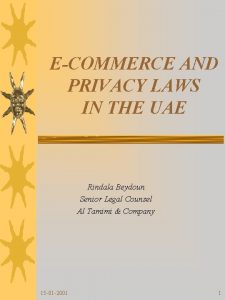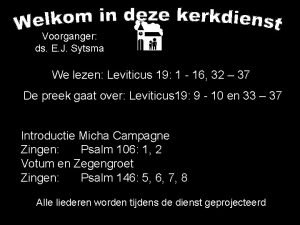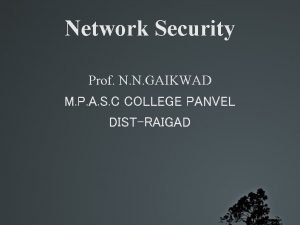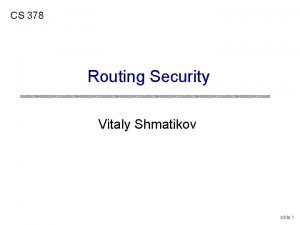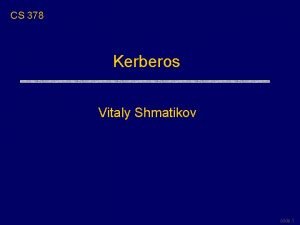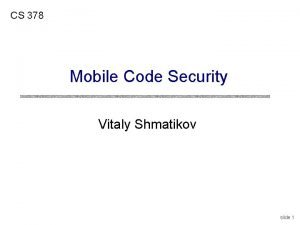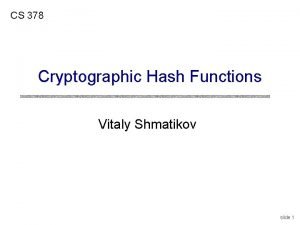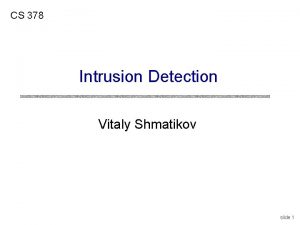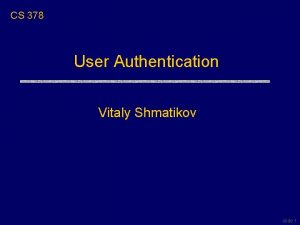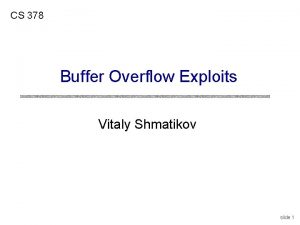CS 378 Stream Ciphers Vitaly Shmatikov slide 1










- Slides: 10

CS 378 Stream Ciphers Vitaly Shmatikov slide 1

Stream Ciphers u. Remember one-time pad? Ciphertext(Key, Message)=Message Key • Key must be a random bit sequence as long as message u. Idea: replace “random” with “pseudo-random” • Encrypt with pseudo-random number generator (PRNG) • PRNG takes a short, truly random secret seed (key) and expands it into a long “random-looking” sequence – E. g. , 128 -bit key into a 106 -bit pseudo-random sequence Randomness amplification (remember HMAC? ) u. Ciphertext(Key, Message)=Message PRNG(Key) • Message processed bit by bit, not in blocks 2

Properties of Stream Ciphers u. Usually very fast • Used where speed is important: Wi. Fi, SSL, DVD u. Unlike one-time pad, stream ciphers do not provide perfect secrecy • Only as secure as the underlying PRNG • If used properly, can be as secure as block ciphers u. PRNG must be unpredictable • Given the stream of PRNG output (but not the seed!), it’s hard to predict what the next bit will be – If PRNG(unknown seed)=b 1…bi, then bi+1 is “ 0” with probability ½, “ 1” with probability ½ 3

Weaknesses of Stream Ciphers u. No integrity • Associativity & commutativity: (X Y) Z=(X Z) Y • (M 1 PRNG(key)) M 2 = (M 1 M 2) PRNG(key) u. Known plaintext attack very dangerous if keystream is ever repeated • Self-cancellation property of XOR: X X=0 • (M 1 PRNG(key)) (M 2 PRNG(key)) = M 1 M 2 • If attacker knows M 1, then easily recovers M 2 – Most plaintexts contain enough redundancy that knowledge of M 1 or M 2 is not even necessary to recover both from M 1 M 2 4

Stream Cipher Terminology u. Seed of pseudo-random generator often consists of initialization vector (IV) and key • IV is usually sent with the ciphertext • The key is a secret known only to the sender and the recipient, not sent with the ciphertext u. The pseudo-random bit stream produced by PRNG(IV, key) is referred to as keystream u. Encrypt message by XORing with keystream • ciphertext = message keystream 5

RC 4 u. Designed by Ron Rivest for RSA in 1987 u. Simple, fast, widely used • SSL/TLS for Web security, WEP for wireless Byte array S[256] contains a permutation of numbers from 0 to 255 i = j : = 0 loop i : = (i+1) mod 256 j : = (j+S[i]) mod 256 swap(S[i], S[j]) output (S[i]+S[j]) mod 256 end loop 6

RC 4 Initialization Key can be any length Divide key K into L bytes up to 2048 bits for i = 0 to 255 do S[i] : = i j : = 0 for i = 0 to 255 do Generate initial permutation j : = (j+S[i]+K[i mod L]) mod 256 from key K swap(S[i], S[j]) u To use RC 4, usually prepend initialization vector (IV) to the key • IV can be random, a counter, or flip between two values • IV is often sent in the clear with the ciphertext Fluhrer-Mantin. Shamir attack u RC 4 is not random enough! 1 st byte of generated sequence depends only on 3 cells of state array S. This can be used to extract the key. • To use RC 4 securely, RSA suggests discarding first 256 bytes 7

Linear Feedback Shift Register (LFSR) Example: 4 -bit LFSR b 0 b 1 b 2 b 3 add to pseudo-random sequence u. Key is used as the seed • For example, if the seed is 1001, the generated sequence is 1001101011110001001… u. Repeats after 15 bits (24 -1) 8

Content Scrambling System (CSS) u DVD encryption scheme from Matsushita and Toshiba Each player has its own PLAYER KEY (409 player manufacturers, each has its player key) KEY DATA BLOCK contains disk key encrypted with 409 different player keys: Each DVD is encrypted with a disk-specific 40 -bit DISK KEY • Encrypt. Disk. Key(Disk. Key) • Encrypt. Player. Key 1(Disk. Key) … Encrypt. Player. Key 409(Disk. Key) This helps attacker verify his guess of disk key What happens if even a single player key is compromised? 9

Attack on CSS Decryption Scheme 1 seeded in 4 th bit 16 bits disk key … 24 bits 1 seeded in LFSR-17 4 th bit Encrypt. Disk. Key(Disk. Key) stored on disk [due to Frank Stevenson] +mod 256 … LFSR-25 Decrypted title key invert carry Encrypted title key Table-based “mangling” Knowing encrypted and decrypted title key, try 256 possibilities to recover 40 output bits of the LFSRs – this takes O(28) Guess 16 bits of the key contained in LFSR-17 – this takes O(216) Clock out 24 bits out of LFSR-17, use them to determine the corresponding output bits of LFSR-25 (this reveals all of LFSR-25 except the highest bit) Clock back 24 bits, try both possibilities – this takes O(2) This attack takes O(225) Verify the key 10
